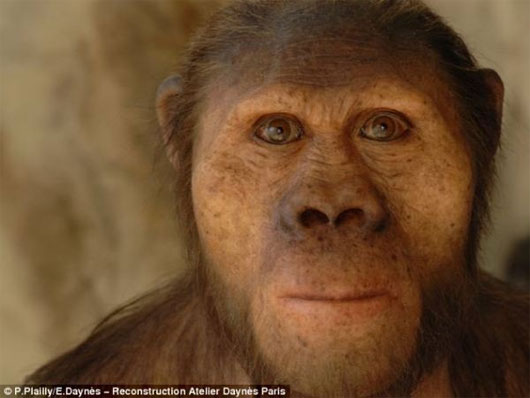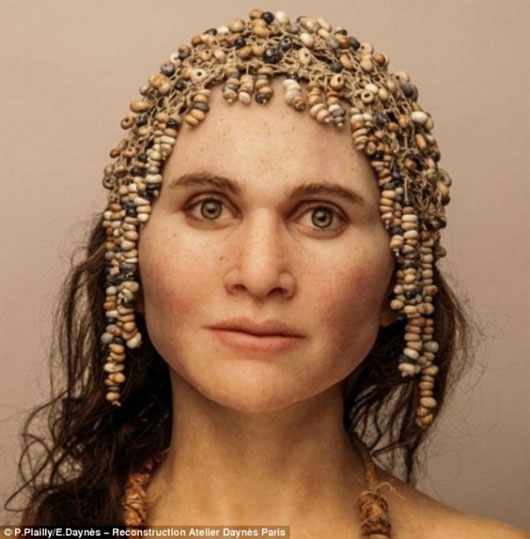A close-up picture of the original human image
We like to meet the ancient ancestors of humanity through lifelike specimens.
Recently, French artist Elisabeth Daynès created ancient human models with accuracy and realism to every little detail like freckles, wrinkles, soulful eyes. Thus, we can first meet directly with human ancestors.
Elisabeth's idea stems from her need to create original human masks for the theater. After being attracted to and learning about human evolution, Elisabeth recreated Lucy - a model of Australopithecus afarensis that lived about 2-3 million years ago, along with many primitive human models. The wise man (Hominids) and the erect (Homo erectus).

The model is so realistic that it depicts every little detail on the face like wrinkles and freckles.
Elisabeth shared that the main purpose of implementing this project was to turn the remains of fossil bones into real people, with faces and distinctive identities. Even, she was so passionate about work that, whenever she saw any ancient skull, she envisioned the corresponding face.

The process of building the specimen begins with the formation of the skull structure.
Elisabeth's first task was to replicate the model of a fluffy mammoth and a group of Magdalenians living 11,000 years ago. In order to create the most realistic model, she conducted a test on the structure of this human's skull, because the skull is a factor that makes much difference between different groups of people.
Then, with the help of the computer, she continued to develop ideas about the muscles, nose, forehead and chin. The clay is used to create the built shape, and from the results of understanding the structure of bones and teeth, the face will be built completely.

Each specimen possesses its own identity and emotions.
Finally, the silicon mold with all the small details such as the subcutaneous veins, wrinkles, crow's feet . will be applied to the clay statues, creating a complete and "soulful" image for the model. object.
To determine the right eye color and hair color, Elisabeth references literary materials and learns that the historical Neanderthals have red hair color. Elisabeth uses real human hair, mixed with Tibetan fur to create hair for the specimens. The reason is that primitive people have quite thick and rough hair.


The hair and hair part of the specimen is made from real human hair and Tibetan fur.
In particular, Elisabeth was very hard at creating wrinkles on her face, drawing shadows for her eyes so that the specimens looked really soul-like.
Likewise, with all the later models, she followed two steps.
The first is to carefully study the general characteristics of the group of people with the same skull structure, then focus on learning to form individual characteristics of each individual, making the specimen also have emotional nuances and characteristics. Identify as a modern person.

The process of shaping complies with 2 steps: finding common characteristics of groups of people with skull structure and developing specific identification characteristics for each individual.
She shared that each model has a lot of knowledge about the origins of humanity and this project has given the public the opportunity to face ancestors from millions of years ago.
Elisabeth also believes that, even now, primitive people are always attached to violent, instinctive images, but she will instill a sense of humanity into the samples, making viewers feel the feeling. contact people in these terracotta models.
- For the first time, the image of ovulation is recorded
- Behind the strange yellow color in this photo, many people shudder
- Gossiping cameras do not let you take a 'snap' with anyone
- NASA explains the human skeleton image on Mars
- The first 3-D image in human arteries
- The final picture of Opportunity robot was captured and it hurt the online community
- How did the owner of Playboy help create a JPEG image format?
- South Korea: successfully excavated a 1,300-year-old Buddha image
- The picture has 'ghost': Suddenly an extra person appears thanks to a cut
- Why do we often close our eyes when we kiss?
- Original movie about the moon landing is deleted
- The clearest picture of the sun flare
 'Fine laughs' - Scary and painful torture in ancient times
'Fine laughs' - Scary and painful torture in ancient times The sequence of numbers 142857 of the Egyptian pyramids is known as the strangest number in the world - Why?
The sequence of numbers 142857 of the Egyptian pyramids is known as the strangest number in the world - Why? History of the iron
History of the iron What is alum?
What is alum?